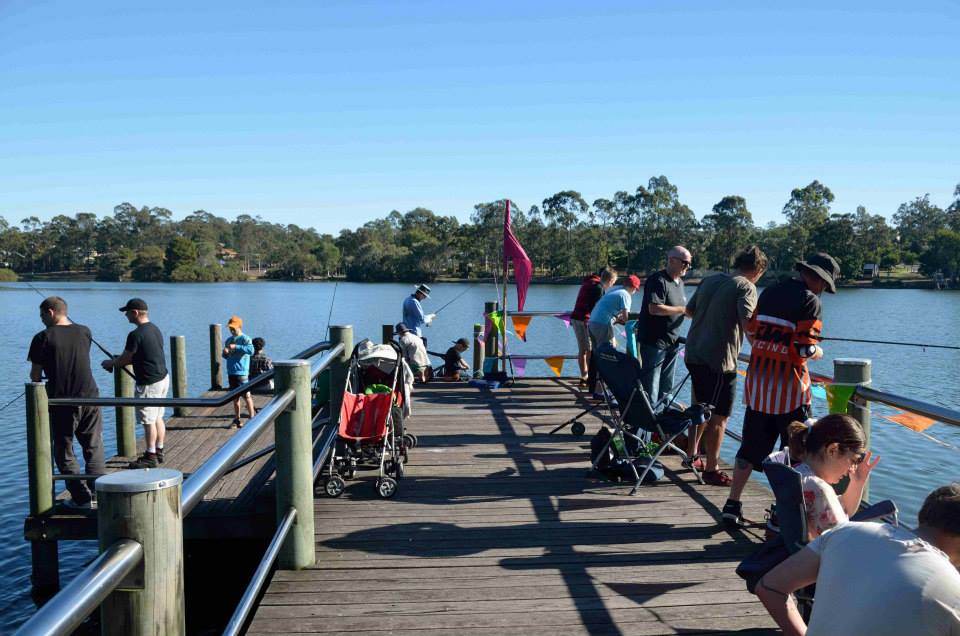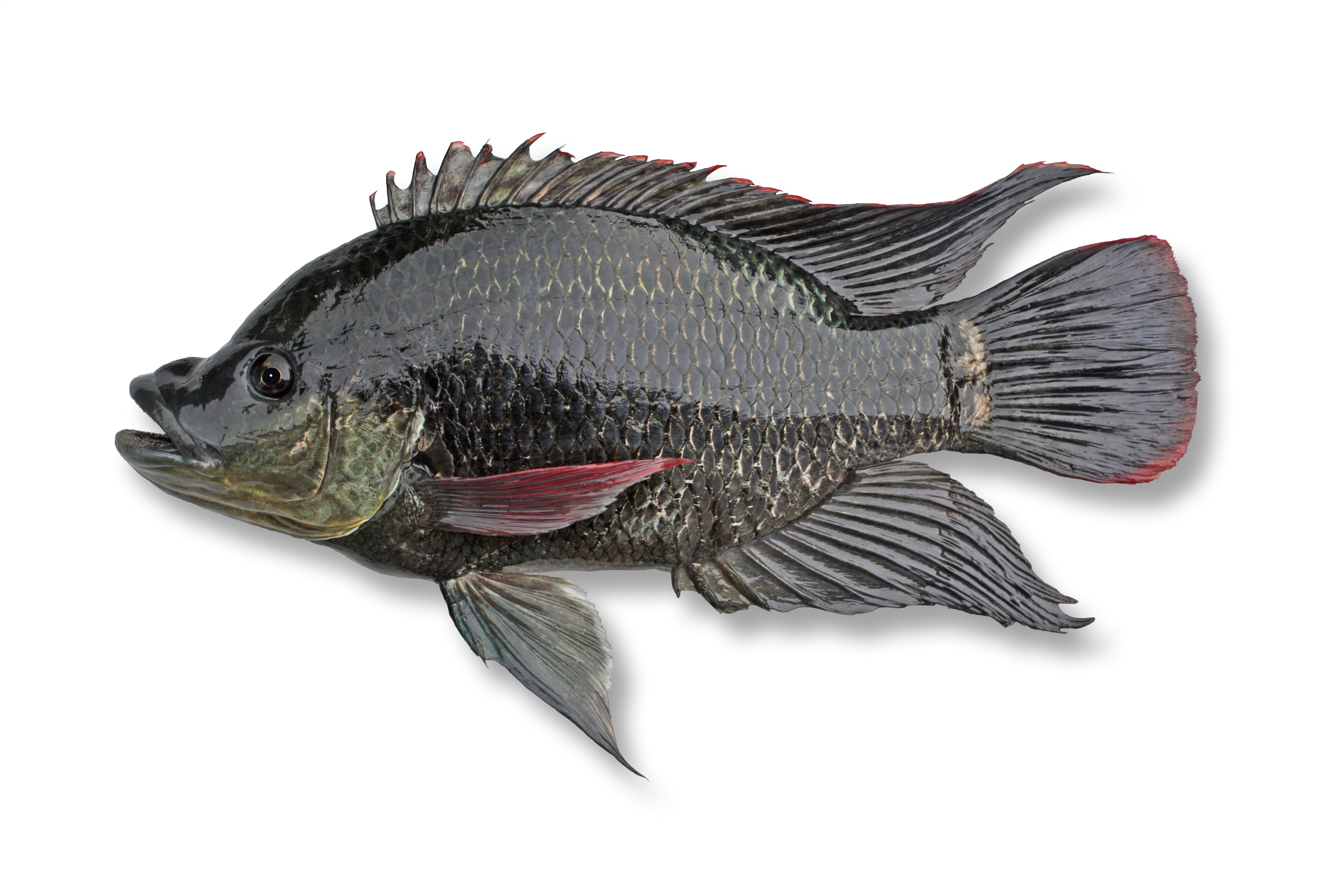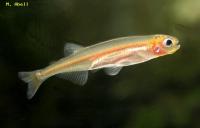If you didn’t make it along to the BCC Pest Fish Education Event you missed a fantastic morning out. The water might have been too cool for the Tilapia to bite but there were lots of other fish being reeled in. We were all impressed with the variety of native fish in the lake despite invasions from African Tilapia, American Gambusia and North Queensland Barred Grunter. There might have been a few fish that went back without being tallied but we did our best to count everything that came in – checkout the stats below. The barbless hooks provided by BCC ensured fish were able to be returned to the water in good condition. I still haven’t found out who managed to land gambusia while line-fishing…
By Greg Wallis (pseudechis) at YouTube
The Tarpon or Ox-eye Herring (Megalops cyprinoides) is a common fish found in the rivers and coastal areas of northern Australia. It is also found through much of the tropics from east Africa, across the Indian Ocean to South-east Asia. It is also commonly referred to as the Indo-Pacific Tarpon outside of Australian waters.The Tarpon/Oxeye Herring from Australian waters should not be confused with the much larger Atlantic Tarpon (Megalops atlanticus) from the americas. The fish at the end of the video is a Black Catfish (Neosilurus ater).
Although the Oxeye Herring can grow to well over a metre, it is more commonly seen up to around 50 cm. Larger fish are normally found in marine waters.
The tarpon can often be seen flashing and “gulping” air at the waters surface; it can tolerate low oxygen levels in the water due to it’s ability to supplement it’s oxygen supply via air that is gulped into it’s modified swim bladder.
Tarpon are highly regarded as a sportfish because of their fighting ability on light tackle. They are often observed actively feeding on the surface of tropical billabongs in the early morning and late afternoon where they are easily caught on flies and lures although they are regarded as poor eating because of the large number of fine bones.
For more information on Oxeye Herring see the Fishes of Australia website at:
http://www.fishesofaustralia.net.au/h…
CAAB Taxon Code: 37054001
Where: Forest Lake Boulevard Park
Date: Sunday 25 May 2014
Time: From 9am – 12pm
Cost: Free
Learn how to identify pest fish species and the impact they pose on our native fish and aquatic habitat. During the event, residents will able to fish for Tilapia, a hardy fish whose effective breeding habits can lead to it overrunning native species, other noxious fish such as carp, and ornamental fish commonly kept in home aquariums such as goldfish. To take part in the fishing activity, residents are asked to sign up at the registration marquee near the Stage area at the parklands where they will be directed to one of the designated fishing sites around the lake.
There will also be a free sausage sizzle.
Participants will be required to bring along their own fishing rod and line. Barb-free hooks will be provided to reduce the impact on native bycatch that will be returned to the water. Bait will be available on site.
As this is an outdoors event, participants should also bring water, sun smart clothing, hat, sunscreen and enclosed shoes. All children, under the age of 18, must be accompanied by an adult.
Note: Fishing in Forest Lake is normally prohibited, however Council has approval to oversee this one off event to raise awareness for and manage this pest species.
More information about pest fish is available from the Department of Agriculture, Fisheries and Forestry.
By Greg Wallis (pseudechis) at YouTube
The Barramundi or Giant Perch (Lates calcarifer) is an iconic fish from the freshwater billabongs, estuaries and coastline of northern Australia. Growing to 180cm and 60kg in size, these fish are a formidable predator.
Hatchling Barramundi are almost entirely males and spend their first year around mangroves and floodplain lagoons before moving further upstream into freshwater. At around 3 — 5 years of age and 60 — 80 cms the fish change sex and become female and move downstream to the tidal river mouths to breed.
Generally speaking it’s not a good idea to swim in natural waterways where Barramundi occur. Because they migrate from upstream freshwater areas down to the mouths of the rivers and back again, if you see Barramundi in a swimming hole it means that there are no substantial barriers downstream impeding their movement up from the coast, which also means Saltwater Crocodiles will have no problems in also accessing the area!
Barramundi are highly prized by fisherman both for their eating and fighting qualities. They are a very important food source for Aboriginal people and are regularly depicted in bark paintings and rock art.
For more information on Barramundi see the Fishes of Australia website
http://www.fishesofaustralia.net.au/h…
CAAB Taxon Code: 37310006
By Greg Wallis (pseudechis) at YouTube
This school of Northwest Glassfish (Ambassis sp.) was filmed in a rainforest spring tributary of the Finniss River near Batchelor in the Northern Territory of Australia. Although this species is very common it remains officially undescribed. At one stage it was referred to as Ambassis muelleri which is now a synonym of Ambassis agassizii, a fish found through much of the Murray River system much further south.
For information on Northwest Glassfish see the fact sheet at Aquagreen
http://www.aquagreen.com.au/plant_dat…
For information on a closely related species the Sailfin Glassfish, Ambassis agrammus see the Fishes of Australia website
http://www.fishesofaustralia.net.au/h…
CAAB Taxon Code: 37310008 a closely related species
Filmed with a Gopro Hero HD1 camera with an “eye of mine” housing
By Greg Wallis (pseudechis) at YouTube
Barramundi Creek is a major tributary of the South Alligator River in Kakadu National Park. Where it flows off the rocky Arnhem Land escarpment into Barramundi Gorge it is home to a wide variety of freshwater fishes and is an important refuge area for them and other wildlife during the Dry Season months.
The video follows a walk from the carpark up to the plunge pool and explores some of the underwater habitats and their occupants along the way. There are several points where you can stop and watch fish and take in the beautiful surrounds.
Maguk is far more than just a waterfall and a nice place to swim; take some time to soak up the atmosphere, bird calls and the other local wildlife.
If you are swimming please remember this is home to all these animals so go easy on the suncream and insect repellants — better still, swim with a shirt on rather then use suncream. Crocodiles do frequent the area, and National Parks have a policy or removing Saltwater or Estuarine Crocodiles from here and nearby areas but there is no 100% guarantee — you always swim at your own risk. Freshwater or Johnstone River Crocodiles make their home in the area and are best not approached too closely.
The creek is spring fed up in the rocky escarpment and runs throughout the year — from raging floodwaters in the Wet Season months down to a light shower in the late Dry. The area is only accessible to vehicle based tourists during the Dry Season months and it’s always best to check with National Park Headquarters to see if the area is open before you visit.
The video shows a variety of fish that are commonly seen at the gorge, but it is far from being comprehensive.
Please note: Fishing is NOT allowed in this area or in most areas east of the Kakadu Highway (with a couple of exceptions). Because these waters remain throughout the year, they are a very important refuge for many species of fish. Many stick it out here during the Dry only to move downstream to breed on the floodplains during the Wet Season and then back to the refuges again for the Dry. There are plenty of places you can fish much further downstream in the big tidal rivers and floodplain billabongs.
By Greg Wallis (pseudechis) at YouTube
These Spotted Galaxias were filmed at Waratah Bay in Cape Liptrap Coastal Park. The Common Jollytail or Common Galaxias (Galaxias maculatus) can also be seen briefly at several points in the video; eg (00:48 in the background) and at 01:40 where one darts across the screen twice
For more information on Spotted Galaxias see:
http://www.fishesofaustralia.net.au/h…
CAAB Taxon Code: 37102010
YouTube video by Barracod
Some underwater footage of Native Australian fish, crimson spot rainbowfish, pacific blue eyes, smelts and hardy heads in Booloumba creek part of the Mary river catchment in the Sunshine Coast Hinterland
Date: Sunday 13 April 2014
Expected Species:
- Rhadinocentrus ornatus (Ornate Rainbowfish)
- Melanotaenia duboulayi (Crimson Spotted Rainbowfish)
- Pseudomugil signifer (Pacific Blue-eyes)
- Retropinna semoni (Smelt)
- Hypseleotris galii (Firetail Gudgeon
- Gobiomorphus australis (Striped Gudgeon)
- Gambusia holbrooki (Mosquito Fish or Plague Minnows)
- Eels
- Australatya Striolata (Riffle Shrimp)
[s2If !current_user_can(access_s2member_level1)]
Field trip details are restricted to ANGFA Qld members.
[/s2If][s2If !current_user_can(access_s2member_level1) && is_user_logged_in()]
If you are a member please contact us so we can fix your account.
[/s2If][s2If !is_user_logged_in()]
Click here to log in or register.
[/s2If][s2If current_user_can(access_s2member_level1)]
Meeting Location:
Hungry Jacks Tugun. The Hungry Jacks and Shell Service Station complex is located on the western side of the Gold Coast Highway between Karana St and Tooloona St. Heading south along the Pacific Motorway you need to take the Currumbin exit (see signs to Currumbin Wildlife Sanctuary). Head east towards the beach.
At the Gold Coast highway turn right, then conduct a U-Turn at the next set of lights (you will then be heading north towards Brisbane). Hungry Jacks will be on your immediate left and we’ll be facing in the right direction for the field trip. Coordinates for Hungry Jacks Tugun are:
Lat: 28° 8.634’S, Long: 153° 29.609’E
Gregory’s UBD Street Directory 2013 – Gold Coast Map 71, Reference F10
Departure Time:
8.30am. This is the time we will leave the meeting point.
Program:
This program is tentative only and may change due to weather and water levels
- 0830 – 0900: Travel to first fishing location.
- 0900 – 1000: Fish first location (Currumbin Ck)
- 1000 – 1030: Travel to second fishing location.
- 1030 – 1130: Fish second location (Tallebudgera Ck)
- 1130 – 1145: Travel to third fishing location.
- 1145 – 1245: Fish third location (Tallebudgera Ck)
- 1245 – 1300: Travel to lunch location
- 1300 – 1400: Lunch at local Café
CHECK THE ANGFA FORUM THE FRIDAY OR SATURDAY BEFORE THE TRIP TO CONFIRM THAT IT’S STILL ON
What to Bring:
Wading boots or waders, dip nets, folding bait traps, bait or burley for the traps, buckets (with lids), a field tank for photography, an esky or styrofoam box to hold the fish in, plastic bags for the fish, rubber bands, non- iodised salt (cooking salt, rock salt, etc), drinking water, sunscreen and insect repellent (expect sand flies), fish and plant identification books, goggles and snorkel, and water test kits if you have them (hardness, total hardness, pH, dissolved oxygen, salinity, etc).
Remember:
We are a conservation society and expect to take due care of the locations and wild populations we collect from and the fish we collect. Take only as much as you need to display or breed. It is illegal to sell fish from the wild without a licence.
An important part of each field trip is to survey and record the water conditions and what we find, and any assistance with this task will be appreciated.
Size and bag limits and equipment regulations apply when fishing in fresh water in QLD. You can find the QLD bag and size limits here: http://www.dpi.qld.gov.au/28_2994.htm You can find the QLD fishing equipment regulations here: http://www.dpi.qld.gov.au/28_3023.htm
Nomination:
To nominate for the field trip please contact the Field Trip Coordinator: Leo O’Reilly, Mob: 0438 733 789, Email: oreilly1@bluemaxx.com.au
If you have nominated for the trip you will be provided with maps and directions at the meeting point.[/s2If]
YouTube video by Barracod
Species encountered in the freshwater reaches of Currumbin Creek near the Gold Coast.
Ornate rainbowfish (Rhadinocentrus ornatus), Australian Smelt (Retropinna semoni) as well as Freshwater Eels and various shrimp


